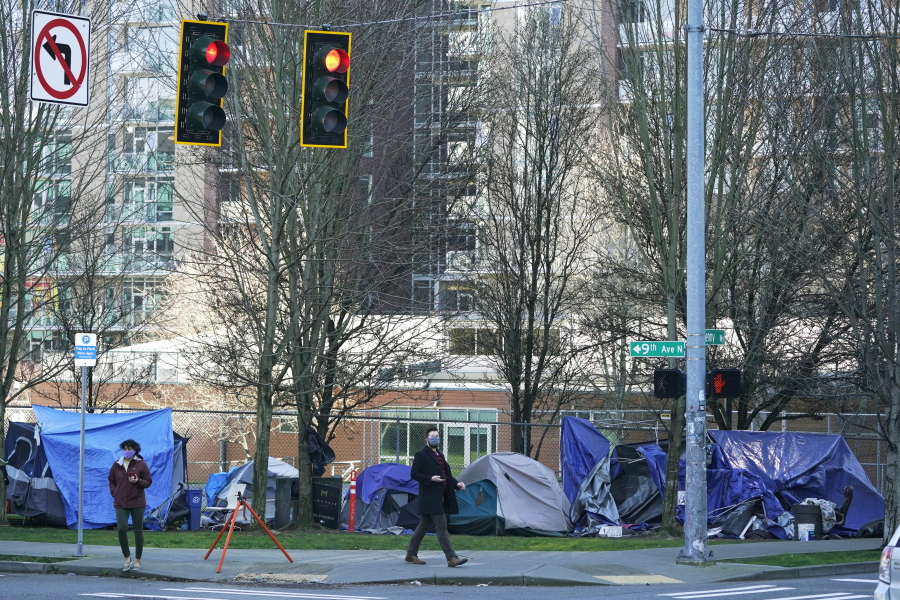SEATTLE — When Aaliyah Bains was hired as a building assistant at the Bob and Marcia Almquist Place in July 2020, she knew it would be a tough job. She knew it was home to more than 100 newly housed, disabled people, most of whom had moved in after years in homeless shelters or the street.
She also knew she’d be making less than $40,000 a year and could only afford a 200-square-foot studio in the University District. But she was a college student and thought she could make it work. And for over a year, she did — she didn’t even have to apply for the food stamps she qualified for.
But Bains wasn’t prepared for just how tough her job would be.
Many nonprofit leaders have wished their whole careers that the federal government would step in and put more money into addressing homelessness, and now at the same time there’s more federal money pouring into the city and county to house people than in recent memory, they’re watching their workforce melt down.
At Almquist Place, even after Bains was promoted to housing case manager and started making closer to $45,000, she had to pay for her own masks for much of 2020; she was responsible for persuading COVID-19-positive tenants to quarantine, then delivering food and filling any needs for the few who did; and when a few troubled tenants would brandish knives or threaten to hurt someone, she’d call the police and they often wouldn’t come.
For all this, the 21-year-old and her co-workers lived paycheck to paycheck.
But while pay in this sector has always been notoriously awful and few last for long, the pandemic and the ensuing labor shortage in nearly every low-paying sector have brought it to crisis levels, according to nonprofit leaders in Seattle.
Last month, Bains quit. Her story is all too common in the meat grinder of homeless services, where about 160,000 full- and part-time workers across the U.S. make an average $24,000 a year and turnover is high.
The issue has gotten so bad that it could stall plans to expand the shelter system this fall with newly bought and funded hotels, apartment buildings and “enhanced shelters” to try to recoup after COVID-19 upended traditional mats-on-the-ground homeless shelters.
“We don’t want this moment to pass us by where we can really make the huge dent we want to make in our homeless crisis,” said Noah Fay, housing program director at the Downtown Emergency Service Center, one of Seattle’s largest homelessness nonprofits. “But I really worry we just can’t get the workforce to make that happen.”
There are currently 142 openings at the nonprofit, which has already added 141 positions since the start of the pandemic, according to Fay. At an organization with more than 800 employees, there’s a vacancy rate of nearly 18 percent. Average starting pay at Downtown Emergency Service Center and Catholic Community Services of Western Washington, another large shelter nonprofit, is about $18 an hour for front-line staff.
The stalled hiring is also complicating campaign promises from King County Executive Dow Constantine, whose administration has overseen the purchase of seven hotels and a new apartment building with money from a new sales tax. He promised to permanently house 1,600 people — more than a third of the chronically homeless people in the county.
But only four of those buildings are scheduled to open this fall, and of those four, only one adds beds to the system. Two are replacing capacity lost elsewhere in the system, according to Fay at Downtown Emergency Service Center. One has been serving as a socially distanced shelter for people moved out of crowded shelters at the beginning of the pandemic.
“The open question of ‘Can we find people to actually do the work,’ is something that keeps us up — keeps me up — many nights,” Fay said.
Case managers at three of the region’s biggest shelter providers — Downtown Emergency Service Center, YouthCare and Low-Income Housing Institute — average between $47,000 and $52,000 a year, according to a spokesperson for the King County Regional Homelessness Authority. In comparison, Seattle’s median income was $102,500 as of 2019. The authority’s newly hired CEO Marc Dones has made improving pay one of its priorities.
Compensation at the top varies much more at these nonprofits. According to tax documents, the executive director of the Downtown Emergency Service Center made a little over $130,000 in 2019, whereas Catholic Community Services’ president made more than $300,000 last year.



